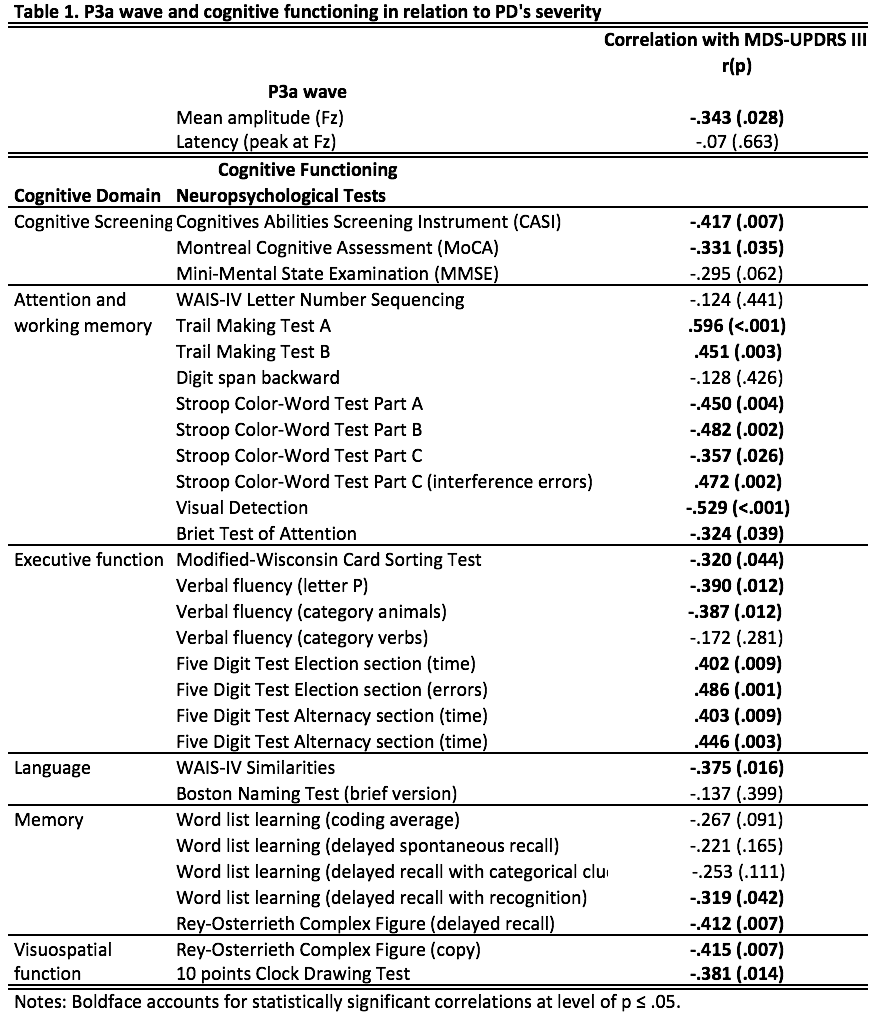Session Information
Date: Wednesday, September 25, 2019
Session Title: Cognition and Cognitive Disorders
Session Time: 1:15pm-2:45pm
Location: Agora 3 East, Level 3
Objective: To explore the association between the P3a wave, cognitive decline, and severity of Parkinson’s disease (PD).
Background: It has been proposed that cognitive changes in PD obey an antero-posterior sequence as disease progresses, but it has not been entirely described their association with disease’s severity. On the other hand, the P3a wave has been proposed as a reliable marker of PD’s progression, but it is not clear whether it has a relation with different cognitive functions or with PD’s severity [1]. As PD involves neurodegenerative processes, it is relevant to identify the potential moderator effects of severity when accounting for disease’s cognitive and electrophysiological changes.
Method: Participants were 31 PD patients and 11 healthy controls (HC) similar in age and education. All patients were recruited from the National Institute of Neurology and Neurosurgery in Mexico City. All the participants carried out an exhaustive neuropsychological assessment in accordance to the MDS Taks Force criteria [2]. Severity of the disease was assessed using the MDS-Unified Parkinson’s Disease Rating Scale Part III (MDS-UPDRS III). A classic auditory oddball task (800 stimuli, 85% frequent, 15% deviant) was performed by all participants while an EEG was recorded from 60 channels in order to obtain the P3a wave.
Results: The P3a amplitude was significantly smaller in the PD group (p=.03). Few differences were found for neuropsychological domains between groups, all of which favored HC over PD group, and included the copy of the Rey-Osterrieth Complex Figure (p=.02), Visual Detection Task (p=.003), Trail Making Test A and B (p=.005 and p=.004 respectively), and the Five Digit Test (shifting, p=.002). Both the P3a and almost all neuropsychological scores were significantly associated with PD severity [table1].
Conclusion: The P3a showed an amplitude reduction in the PD group and a negative correlation with severity. Though few cognitive differences were found by just considering clinical vs control groups, most of the test scores showed significant correlations with severity. Thus, cognitive decline in patients shall not be accounted just by presence of the pathology but by its interaction with severity. Given its association with severity and cognitive decline, our results support the proposal of considering the P3a as a biomarker of disease progression.
References: 1. Solís-Vivanco, R., Rodríguez-Violante, M., Rodríguez-Agudelo, Y., Schilmann, A., Rodríguez-Ortiz, U., & Ricardo-Garcell, J. (2015). The P3a wave: A reliable neurophysiological measure of Parkinson’s disease duration and severity. Clinical Neurophysiology, 126, 2142-2149. 2. Litvan, I., Goldman, J. G., Tröster, A. I., Schmand, B. A., Weintraub, D., Petersen, R. C., … Emre, M. (2012). Diagnostic criteria for Mild Cognitive Impairment in Parkinson’s disease: Movement Disorder Society Task Force Guidelines. Movement Disorders, 27(3), 349-356.
To cite this abstract in AMA style:
G. Sánchez Dinorín, M. Rodríguez Violante, A. Cervantes Arriaga, C. Navarro Roa, R. Solís Vivanco. The P3a wave and cognitive decline in relation to Parkinson’s disease severity [abstract]. Mov Disord. 2019; 34 (suppl 2). https://www.mdsabstracts.org/abstract/the-p3a-wave-and-cognitive-decline-in-relation-to-parkinsons-disease-severity/. Accessed December 28, 2025.« Back to 2019 International Congress
MDS Abstracts - https://www.mdsabstracts.org/abstract/the-p3a-wave-and-cognitive-decline-in-relation-to-parkinsons-disease-severity/

